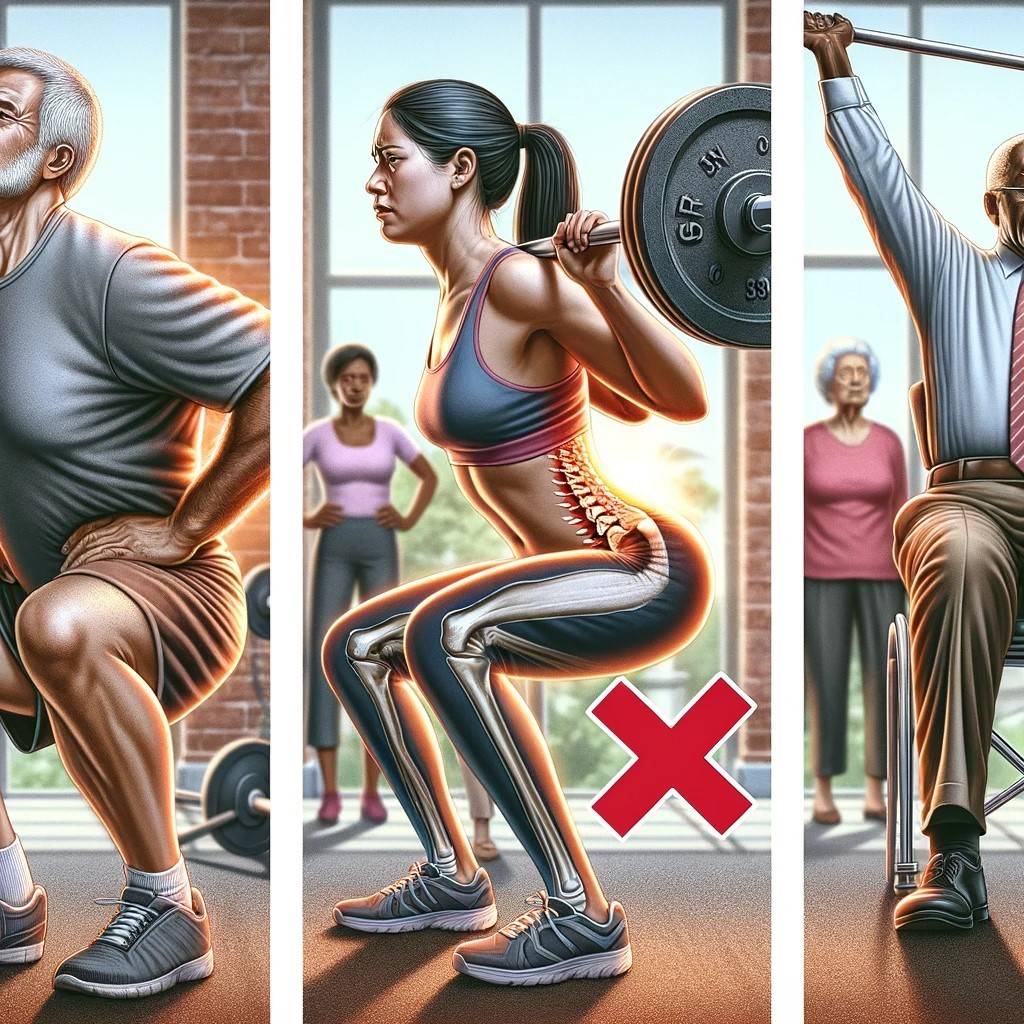Discover essential insights on Lower Back Pain Exercises to Avoid in this comprehensive guide. Safeguard your lumbar health with expert tips for a pain-free life.
Lower Back Pain Exercises to Avoid Safeguard Your Lumbar Health
Introduction
Lower back pain is a prevalent issue affecting a wide demographic. This comprehensive guide delves into lower back pain exercises to avoid maintain a healthy lumbar region, thus reducing the risk of aggravating back pain.
Understanding Lower Back Pain and Exercises to Avoid

The Anatomy of the Lower Back
The lower back, called the lumbar region, is like a puzzle of bones, joints, nerves, and muscles. It gives support and flexibility, but it can also get hurt and cause pain.
Key Points:
- Vertebrae: The lumbar spine consists of five vertebrae labelled L1 through L5.
- Intervertebral Discs: These act as cushions between the vertebrae and absorb shock.
- Muscles and ligaments: These provide support and enable movement.
Common Causes of Lower Back Pain
Keep reading to learn Lower Back Pain Exercises to Avoid.
Lower back pain can arise from a variety of causes, including but not limited to:
1. Muscle or Ligament Strain: Frequent lifting of heavy objects or an unexpected awkward motion can lead to strain in the muscles of your back and the ligaments in your spine.
2. Bulging or Ruptured Discs: Discs act as cushions between the bones in your spine. The soft material inside a disc can bulge or rupture and press on a nerve.
3. Arthritis: Osteoarthritis can affect the lower back. In some cases, arthritis in the spine can lead to a narrowing of the space around the spinal cord, a condition called spinal stenosis.
4. Osteoporosis: Your spine’s vertebrae can develop painful fractures if your bones become porous and brittle.
How Exercise Affects Lower Back Pain
While exercise is beneficial for health, certain types of physical activities can aggravate lower back pain. Understanding which exercises to avoid is crucial in managing and preventing further lumbar discomfort.
Key Principles of Safe Exercise for Lower Back Pain
Before we discuss the Lower Back Pain Exercises to Avoid, we will talk about the Basic rules for exercising safely with lower back pain.
The Importance of Proper Form
Improper exercise form can not only negate the benefits of exercise but also pose a significant risk of injury, particularly to the lower back.
Facts to Consider:
- A study by the National Institutes of Health revealed that incorrect posture during exercise can increase stress on the lumbar spine.
- The lumbar spine is particularly susceptible to injury during rotational or bending movements performed incorrectly.
Balancing Exercise and Rest
For individuals with lower back pain, balancing active exercise with adequate rest is essential. Overexertion can exacerbate pain, while insufficient physical activity can lead to muscle weakening and increased pain sensitivity.
Quick Tips:
- Listen to Your Body: If an exercise causes pain, stop immediately.
- Alternate Days: Engage in strengthening exercises on alternate days to allow muscles to recover.
- Quality Over Quantity: Focus on the quality of movements rather than the number of repetitions.
Consultation with Healthcare Professionals
Before starting any exercise regimen, especially when dealing with lower back pain, it’s crucial to consult healthcare professionals. They can provide personalized advice based on your specific condition.
Remember: “Each individual’s back pain is unique, and what works for one person may not be suitable for another,” as noted by a leading physical therapist.
List of Lower Back Pain Exercises to Avoid

I made some mistakes in exercises for my lower back, but after I checked with my healthcare team, I corrected them and avoided the exercises below. Please keep reading to learn what Lower Back Pain Exercises to Avoid.
High-affected Exercises
High-impact exercises can exacerbate lower back pain because of the significant stress they place on the spine.
Examples to Avoid:
- Running on Hard Surfaces: This can jar the spine and worsen the pain.
- Jumping Exercises: Activities like jumping jacks can increase spinal compression.
Weightlifting Mistakes
Certain weightlifting exercises can put undue strain on the lower back, especially when performed with poor form.
Risky Exercises Include:
- Deadlifts: Incorrect form can put immense pressure on the lower back.
- Overhead Presses: These can strain the lumbar region if the core isn’t properly engaged.
Twisting and Bending Movements
Twisting and bending exercises, often found in yoga and Pilates, can be harmful if the lower back is already compromised.
Exercises to Be Cautious with:
- Deep Twists: Can strain the lower back muscles and spinal discs.
- Full Forward Bends: Put pressure on the discs and ligaments in the spine.
Unsupported Back Movements
Exercises that involve unsupported movements of the back can increase the risk of injury.
Avoid Exercises Like:
- Traditional Sit-Ups: These can increase lower back strain.
- Leg Lifts: Can cause lower back arching and strain.
Alternative Exercises for Lower Back Health
Exercises for Building Strength Safely
It’s crucial for individuals experiencing lower back pain to participate in exercises that enhance back strength without adding extra stress.
Recommended Exercises:
- Partial Crunches: These can help strengthen your back and stomach muscles.
- Wall Sits: A successful way to build strength in the lower back and legs without strain.
Stretching and Flexibility
Incorporating stretching and flexibility exercises into your routine can help alleviate lower back pain.
Effective Stretches Include:
- Child’s Pose: This yoga pose helps to elongate and relax the spine.
- Knee-to-Chest Stretch: Gently stretch the lower back and hips.
Core Strengthening
A strong core is vital for supporting the lower back and reducing pain.
Core Exercises:
- Planks: Engage and strengthen the entire core without putting pressure on the lower back.
- Bridges: Target the gluteus and lower back muscles, essential for lumbar support.
Long-Term Strategies for Lower Back Health
Building a Stronger Core
Maintaining a strong core is key to preventing lower back pain over the long term.
Fact: According to the American Council on Exercise, core-strengthening exercises can reduce the likelihood of lower back pain recurrence by up to 40%.
Posture and Ergonomics
Adopting posture and ergonomic practices can significantly impact lower back health.
Key Tips:
- Ensure proper alignment while sitting and standing.
- Use ergonomic chairs and desks to support your lower back.
Lifestyle Adjustments
Making small changes in your daily life can have a significant impact on maintaining a healthy lower back.
Suggestions:
- Maintain a healthy weight to reduce strain on the back.
- Incorporate gentle activities like walking or swimming into your routine.
Conclusion
Being aware of lower back pain exercises to avoid is key to protecting your lumbar health. By incorporating safe exercises and following proper techniques, you can strengthen your lower back and enjoy a healthier, more active lifestyle.
Understanding and avoiding certain exercises is crucial in managing lower back pain. Incorporating safer alternatives and adopting long-term strategies can significantly improve your lumbar health. Always remember to listen to your body and consult healthcare professionals for personalized advice.
FAQs on Lower Back Pain Exercises to Avoid
How I Cured My Lower Back Pain?
Everyone’s journey to managing lower back pain is unique. In my case, I found relief through a combination of rest, avoiding certain exercises that exacerbated the pain (like heavy lifting and high-impact cardio), and incorporating gentle stretches and core-strengthening exercises into my routine. It’s crucial to listen to your body and consult with healthcare professionals for a tailored approach.
How Do I Relax My Lower Back?
Relaxing your lower back can be achieved through several simple techniques:
- Gentle Stretching: Try stretches like the knee-to-chest stretch or a simple child’s pose.
- Heat Therapy: Using a warm compress or heating pad can aid in easing tension in your muscles.
- Mindful Movements: Engage in low-impact activities like walking or swimming that don’t strain the back.
What is the Single Best Exercise for Lower Back Pain?
There’s no one-size-fits-all answer, but many find relief with the bird-dog exercise. It helps strengthen core muscles, which support the lower back, without putting a strain on it. To do it, get on your hands and knees. Stretch one arm in front and the opposite leg back. Hold for a bit, then switch sides.
Is it OK to exercise with Lower Back Pain?
With caution. Choose low-affected exercises that don’t strain your back. Avoid heavy lifting and high-impact activities that I think will worsen the pain. Focus on gentle stretching, core strengthening, and flexibility exercises. Always consult with a healthcare professional before starting any new exercise regimen.
What are the Top 3 Exercises for Back Pain?
- Partial Crunches: These strengthen your stomach and back muscles.
- Wall Sits: They are a way to build endurance in your lower back and legs.
- Bridges: This exercise strengthens the gluteus maximus, which supports the lower back.
What is the Fastest Home Remedy for Back Pain?
The fastest remedy often involves a combination of rest, applying heat or ice packs, and gentle stretching. Heat can relax the muscles, while ice reduces inflammation. Remember, these are temporary measures. For long-term management, it’s best to engage in regular, back-friendly exercises and maintain posture.
Finally
This comprehensive guide provides in-depth insights into managing Lower Back Pain Exercises to Avoid, focusing on what to avoid and what to embrace. Protecting your lumbar health is a journey, and with the right information and practices, it can be a manageable and even empowering one.




